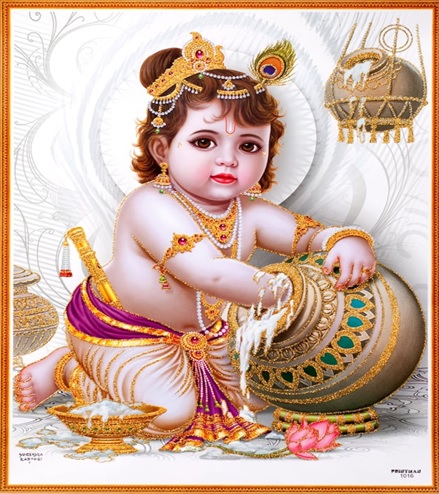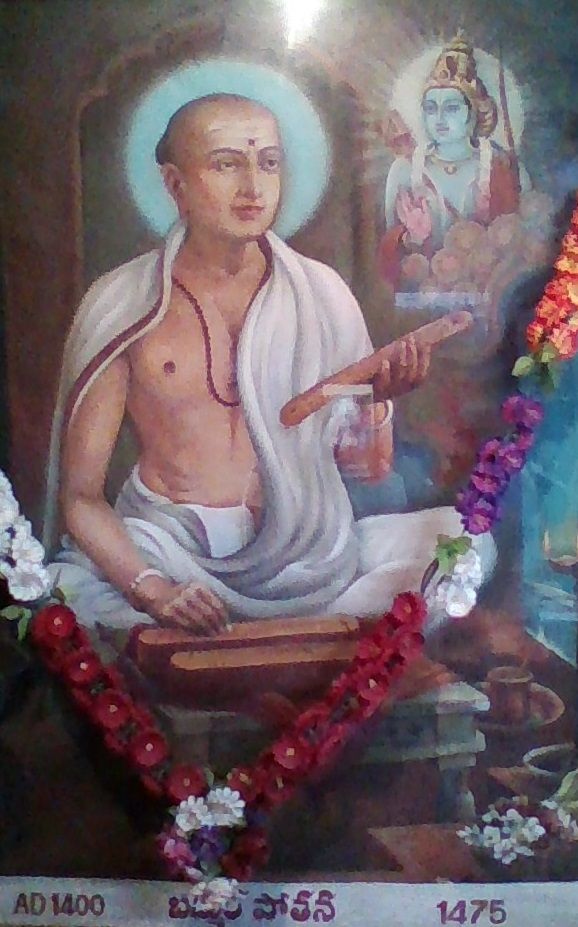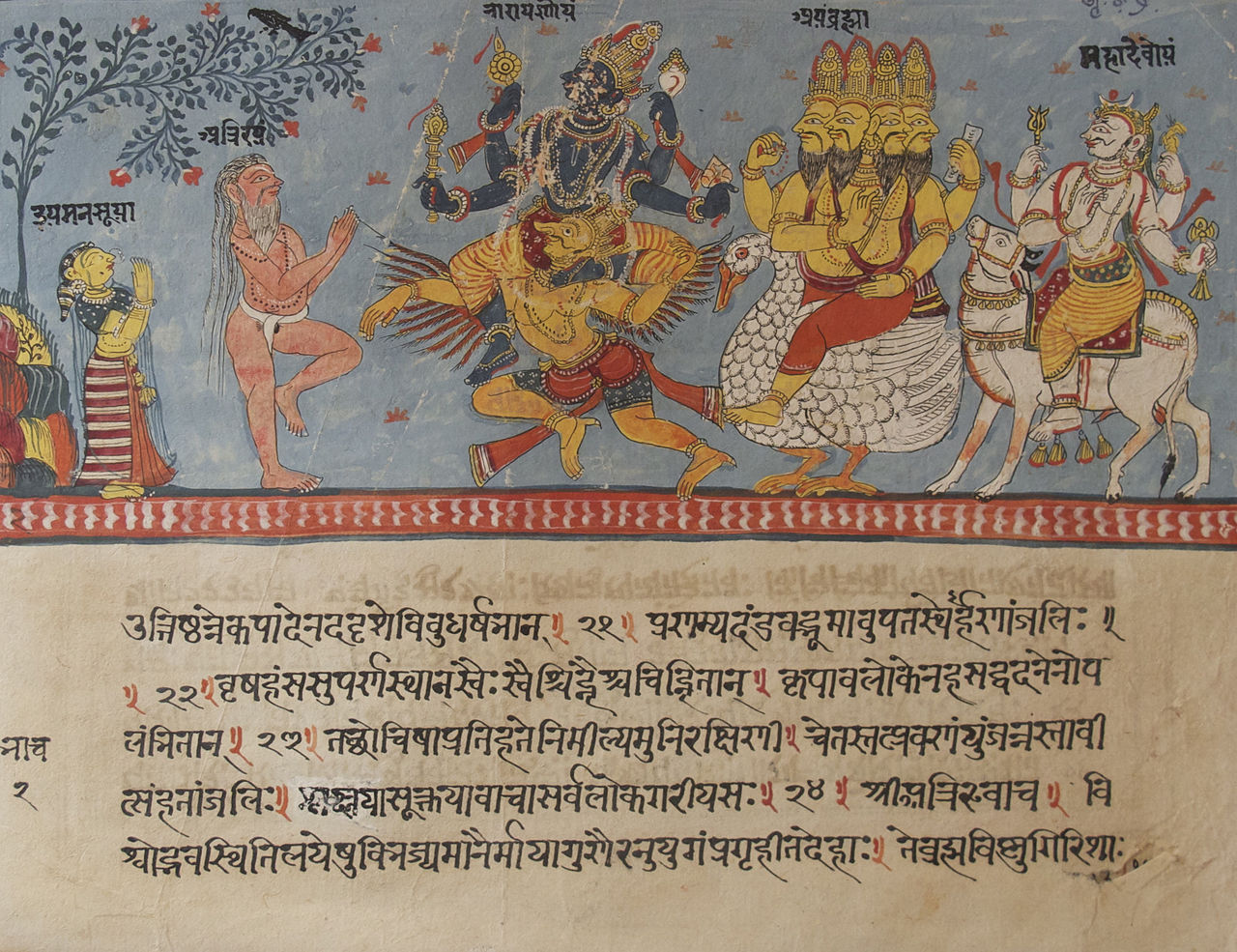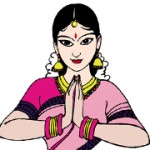The following Post is based on the Translation of Professor T.S.B. Narasaraju garu
To inaugurate Andhra Cultural Portal’s Spotlight on Telugu Literature, is a wonderful work based on one of the most beloved texts in Telugu Poetry.
We are honored to present an excerpt of the Pothana Telugu Bhagatavam, translated into English by Professor T.S.B. Narasaraju.
Much as the Andhra Mahabharatamu is a classic of Telugu literature so too is the Andhra Maha Bhagavatamu another. But at a time when the word Andhra itself is being reduced in scope, what better work to unify all Telugus than the Telugu Bhagavatamu of Telangana’s Pothana.
For those of you who wish to read the Bhagavata Purana translated into contemporary Telugu, please refer to this excellent site: www.telugubhagavatam.org. However, many of our diasporic youth are unable to understand Telugu, let alone, read Telugu script. Therefore, Sri Narasaraju garu has embarked upon this tremendous effort on behalf of all Telugus, to translate key parts of the Mahabhagavatamu, into English. Here is his own selected quote from Pothana’s original to express the sentiment behind his effort to bring a classic to the current day.
kamalakshu narchinchu karamulu karamulu
srinadhuvarninchu jihva jihva
sura rakshakuni chuchu chudkulu chudkulu
seshasayi ki mrokku siramu siramu
Hands deserve to be called as hands only if they pray to the Lord. Tongue is worthy of being called as a tongue only if it praises and describes the Lord. Eyes can be called as eyes only when they see the Lord. Head deserves its name only if it salutes to the Lord
Author
T.S.B. Narasaraju garu is a much respected academic who taught Chemistry at Acharya Nagarjuna University (Guntur) and Banaras Hindu University. He is also learned in traditional Saastriya Telugu, and in his retirement, has embarked upon translating the Bhagavatamu into English for the benefit of our pravasandhra youth.
Professor Narasaraju has done a great service for our Telugu community and we are privileged to bring his work to you in a Series of Articles. These will feature excerpts from his Taatparyam of the Dasama Skandam of Telugu Bhagavatamu.
Publishers and other inquirers can reach Sri Narasaraju via email at:
shamraan@gmail.com
Book
Below we provide an excerpt from Part I of T.S.B. Narasaraju garu’s book:
Dasama Skandha of Potana’s Bhagavata Purana.
It is a translation into English of the 10th Canto of Pothana’s Telugu rendition of the Bhagavata Purana. On request of Professor Narasaraju, we have attached Part I of his 3 Part translation of the Dasama Skandhamu, which can be downloaded at the end of the article.
Without further ado, here are selected excerpts from the book.
[Excerpt. Some emphasis ours.]
Copyright: T.S.B.Narasaraju. All rights reserved. 2017.
DASAMA SKANDHA OF POTANA`S BHAGAVATA PURANA
A Literal Translation into English (Part I)
Foreword
Life on earth is sustained by many essentials. The most important among them, to live with joy and enthusiasm, is love-divine. Although Sri Bhagavata Purana is the quintessence of Karma, Bhakti and Jnana, it primarily elicits love-divine which is transcendental in its experience. Blessed are those who drank the nectar of love! Blessed are the Gopikas who could taste it and got completely merged with Sri Krishna Chaitanyam!
There are many translations of Vyasa Bhagavata Purana into several Indian languages. Its translation into Telugu by Sri Bammera Potana of fourteenth century stands on a high pedestal both in its language and sweetness of Bhava. Its verses are sublime in thought, sweet to chant and easy to memorise. They bring out a vivid picture of stories and expressions of feelings of characters, especially the Leelas of Bhagawan Sri Krishna even to ordinary readers who wish to read them as stories.
Telugu literature with all its lofty thoughts and rich translations is being slowly forgotten by the masses in the din and roar of modern life and its various compulsions. The fact that Puranas, epics and Upanishads, among others, build the character of our nation is not remembered and replaced with a modern craze for standard of living leading to dangerous tendencies.Such a trend causes all kinds of unhealthy comparisons and hatred among people resulting in destruction. These great texts that build character among human beings are going out of reach. Efforts must be made to bring a fresh breeze of life through a revival of a desire for higher knowledge.
It is with this sincere and dedicated thought that Dasama Skandha of Potana`s Bhagavata Purana has been brilliantly translated by Sri T. S. B. Narasaraju into English for the benefit of many residing abroad who lost touch with their mother-tongue, Telugu. Sri Raju`s heart throbbed with enthusiasm to bring Potana`s Bhagavata Purana to children of Telugu resulting in the form of this book.The author introduced the present work very well by giving necessary background in the form of a brief biographical account of Potana, style of his literary prowess, purpose behind the present translation and the sources of inspiration motivating the completion of the present work. In the beginning of the work itself the author brought out the difference between Puranas and Itihasas. This sets the tone of the text and surges the reader ahead with ease in mind and clarity in intellect. His translation is lucid and deep in its flavour. Without losing the essence of the original he brought out the translation in an exemplary manner using simple and effective language. The work is inspiring and holds the reader`s mind with inquisitiveness to read further. It is lucid in style and flows with beauty of expression. The content is absorbing.
The work begins with an invocation seeking the blessings of all those inspiring Sri Raju to grasp the core essence of Srimad Bhagavata Purana. In his Introduction Sri Raju wonderfully described how Potana got motivated by Lord Sri Ramachandra to translate Bhagavata Purana into Telugu from Sanskrit. It was, however, dedicated to Sri Krishna, a Purna Avatara and a Supreme Lord manifesting himself with all his powers unconcealed unlike other incarnations of Lord Vishnu.
It is not an easy task to bring out expressions from Potana`s verses into English. Sri Raju achieved this because of his devotion to the Lord, sincere self-application and taking up the work as a Tapas. I am sure that this work reaches the hands of many inspiring them to read, understand and cultivate the great ideals of Rishis of yore getting motivated to live as beacons of light to many around their lives.
May Lord Sri Krishna bless one and all!
Hari Om!
Swami Chidrupananda
PRELIMINARY ASPECTS
(i) Potana`s Prayers
Sri Krishna, the lord who is a saviour of mankind, skilled in showing grace to his devotees, a destroyer of demons, a creator of several universes by a mere twinkling of his eyes in a playful way and a son of king Nanda and Yasoda is being worshipped to get salvation.
I salute to lord Vighneswara, a recipient of maternal love of Himagirinandini, a cleanser of the sins of Kaliyuga, a source of pleasure to his devotees, a destroyer of impediments of those worshipping him, a centre of joy through his sweet talk to those praying to him and one who relishes Modakas being seated on a Mooshika Vahana.
I pray by prostrating with devotion to lord Siva, the destroyer of pride of Manmadha. He holds a spear in hand, wears a garland of skulls and a crescent moon on head, makes the lotus-like face of Parvati blossom like the sun making the lotuses blossom and resides in the hearts of great ascetics like Narada. Engrossed in a playful dance, he is kind to his devotees like an ocean of grace.
I serve with attention and devotion lord Brahma, a skillful creator of the universe, a donor of happiness to goddess Saraswati, a codifier of the Vedas, a leader to rescue the Devatas, a conqueror of sins, a saviour of devotees and a well-wisher of ascetics.
Touching the floor with my forehead, I salute with devotion to goddess Saraswati having beautiful black locks of hair and carrying a garland of Rudrakshas, a parrot, a lotus and a book in her hands. Having won the heart of lord Brahma, Oh! goddess Saraswati! You are a mother full of condescension. I venture to write Bhagavata Purana in spite of the fact that I do not have the proficiency of any one among Valmiki, Kumara Swamy, Vyasa and Kalidasa, among others. Please grant me adequate competence to fulfill my objective.
I pray to goddess Durga Bhavani to grant me the fortune of a poetic ability of distinction. She is the mother of all mothers being the primordial mother of the three famous mothers, goddesses Lakshmi. Parvati and Saraswati. She is a destroyer of the demons and is the greatest among the mothers. The Devatas have implicit faith in her and hence she stays in the minds of their mothers. Such a goddess Durga is my mother.
May goddess Lakshmi grant us perennial fortunes! She is the empress of lord Sri Hari, an abode of fortunes, a treasure of wealth and prosperity and a sister of the moon god Chandra. Tender as a flower and comparable to a bunch of lotuses she is the play-mate of goddesses Vani and Sarvani and is being worshipped in all the three Lokas. She is a destroyer of poverty through her effulgent looks.
If lord Siva is not worshipped by one with folded hands, lord Hari`s glory is not sung in full throat till it is choked, kindness towards others and righteous living are not cultivated by one, giving such a human birth is a curse to the mother.
(ii) Puranas and Itihasas
A Purana is defined as one among a collection of Sanskrit writings not included in the Vedas . Puranas give an account of births and deeds of Hindu gods as well as of creation and destruction of universe. The literal meaning of a Purana is that which remains perennially new in spite of its ancient origin. Its primary objective is to teach methods of righteous living through a medium of stories. An Itihasa, on the other hand, is an account of historical events which literally happened.
Mahabharata and Ramayana are two famous Itihasas, the latter also being considered to be a Kavya.They are rated to be next only to the Vedas in importance, the Puranas collectively are valued as the fifth Veda. Recent findings established the Puranas, also like Itihasas,to be indispensable sources for establishing authentic Indian history. Puranas are important store-houses to unravel ancient Indian political, religious, social, spiritual and cultural aspects.
In Sanskrit there are eighteen principal Puranas known as Mahapuranas and another eighteen subsidiary Puranas known as Upapuranas. The Mahapuranas are classified into three principal categories based respectively on Siva, Vishnu and Sakti. These originated independently from different pilgrim centers,being places usually heavily crowded and hence amenable for wide publicity.
Vedic literature is difficult to read and understand, a full life-span being inadequate for the purpose for mundane spiritual aspirants. The Puranas provided a suitable milieu as alternatives and hence became popular. It is believed that all the Mahapuranas are written by Vyasa in an easily comprehensible Sanskrit. They function as sources of Dharma and promote principled living ensuring human enlightenment.
The following lines enable one to remember the names of all the eighteen Mahapuranas :-
Bha-dwayam ma-dwayam chaiva bhra-trayam vaa-chatushtayam
Anaapalinga kooskaani puraanaani prachakshate
Bha-dwayam (two starting with Bha-): 1. Bhagavata Purana, 2. Bhavishyapurana
Ma-dwayam (two starting with Ma-) : 3. Markandeyapurana , 4 . Matsyapurana
Bhra-trayam (three starting with Bhra-) : 5. Bhramhapurana, 6. Bhrahmandapurana , 7 . Bhrahmavyvartapurana
Vaa-chatushtayam (four starting with Vi/ Vaa) : 8. Vamanapurana , 9 . Varahapurana, 10. Vayupurana,, 11 .Vishnupurana
Anaapalinga : 12. (A) Agnipurana, 13. (Naa) Naradapurana, 14. (Pa) Padmapurana, 15. (Lin) Lingapurana 16.(Ga) Garudapurana
Kooskani : 17. (Koo) Koormapurana and 18. (Ska) Skaandapurana
(“Bha-Bha-Ma-Ma-Bhra-Bhra-Bhra-Va-Va-Va-Vi-Ana-pa-linga-ku-skani” is
another acronym to remember)
(iii) Bhagavata Purana
Sage Vyasa became Veda Vyasa by classifying the unified form of Vedas into four parts known as Rigveda, Yajurveda,Sama Veda and Adharvana Veda. In addition, Vyasa gave the principles of righteous living through his works. Since reading of Vedas was prohibited to some sections of the population in those days, Vyasa was feeling sad that he could not write something for the benefit of such in their quest for god.
Sage Narada came to the agitated Vyasa. He praised the divine qualities of Vyasa and wanted to know the reasons for Vyasa`s sorrow.Vyasa in return praised Narada`s qualities of uninterrupted devotion to the lord motivating others in all parts of the universe to do the same. Since Narada is omniscient Vyasa requested him to diagnose the reason for Vyasa`s mental agony and to suggest a remedy.
Narada said that though the works of Vyasa were eloquent in establishing the different facets of Dharma, there was no mention of the stories of the lord emphasizing his divine qualities.That, according to Narada, was the reason for the mental agony of Vyasa. According to Narada no literary work, however well- written, was worth the effort without a mention of the lord. Narada said that, on the contrary, even a sub-standard literary work had a sanctifying effect on the reader if it mentioned about the lord. Narada exhorted Vyasa to come out with Bhagavata Purana emphasizing the path of devotion to the lord, praising Hari`s sterling qualities and giving an account of Hari`s incarnations since they were missing in his earlier works. Narada said that listening, thinking and meditating about the almighty supplemented by praising the lord and singing about his glory were the only means for human salvation which transcendeds even proficient learning and rendering of Vedas,Vedanta and Bhagavatgita.
Being thus provoked by Narada and having realized the importance of inculcating the concept of Bhakti, Vyasa wrote Bhagavata Purana meant for universal good and taught it first to his illustrious son Suka. Being requested by king Parikshit tormented by an impending death by the bite of a serpent Takshaka, sage Suka enabled the king to attain Moksha in seven days through the milieu of listening to Bhagavata Purana recited by him. This account describes the genesis of Bhagavata Purana. The origin of Bhagavata Purana is thus the Veda, an abode of all boons. It is delivered by sage Suka as nectar to be relished by the desirous to attain Moksha which is a merger of the human soul with the almighty. Bhagavata Purana is considered to be the most prominent among the Puranas being equivalent to the entire collection of Upanishads. Attainment of Moksha is easier through a devotional and concentrated study of Bhagavata Purana than by reading the entire gamut of Vedas. It is an established fact that the worldly pleasures are temporary. Moksha is permanent and is the ultimate goal of human birth. It is achieved only through the grace of god. One is qualified to get divine grace only through devotion to god adopting Bhakti, knowledge and renunciation.
(iv) Dasaavataras and Importance of Krishnavatara
The Dasavataras, the ten principal incarnations of the lord Vyshnavism are Matsya, Kurma, Varaha, Narasimha, Vamana, Rama, Parasurama, Krishna, Budha and Kaliki. These are given in the following Sloka :-
Matsyaha kurmo varahasche narasimhasche vamanaha
ramoramasche budhaha kalikirevacha
There is no mention of Krishna in this verse. The reason for this is that Krishna transcends the Trimurtys. He is an embodiment of Parabrahma and is considered to be the primordial form of all Avataras.
The following abbreviation in Telugu enables one to remember the names of the ten incarnations and their serial order :- (Ma-Ku-Va-Na,Va-Ri Pelli-Ki-Ba-Ka) : 1. Ma = Matsya , 2. Ku = Kurma, 3. Va = Varaha, 4. Na = Narasimha , 5.Va = Vamana , 6. (R)i = Rama, 7.(P)elli = Parasurama , 8. (Ki) = Krishna, 9. (Ba) = Budha, and 10. Ka = Kalki. (The abbreviation means in Telugu: Makuvana “Rain for us” and Varipelliki Baka “Trumpet for their marriage”)
(vii) Literary Aspects of Potana`s Bhagavata Purana
Bhagavata Purana remains close to the hearts of Telugu-speaking people, particularly the descriptions of Krishna Leelas due to the fact that these aspects were competently described by Potana in his Bhagavata Purana, promoting Madhura Bhakti through selection of simple and sweet vocabulary. It has been emphasized in the scriptures of Hindu religion that realization of god can be through paths of Jnana, Karma and Bhakti.The path of Jnana is difficult and is achieved principally by Rishis and that too only in the form of Nirakara or Nirguna Brahma. The path of Karma is also of restricted utility since it is dependent on gender, caste and age of the devotee. The path of Bhakti is capable of transcending all these obstacles since it has been successfully adopted by the learned, common folk, male and female as well as young and old. Through Mathura Bhakti it is easier to get the Akara or Saguna Brahma. Bhagavata Purana has been playing a significant role in propagating the concept of Navavidha Bhakti, the nine established forms of Bhakti. These are : 1. Sravana (Listening), 2. Sankeertana (Praising), 3. Smarana (Remembering), 4. Paricharya (Praying to lord`s feet), 5. Archana (Worshipping), 6. Vandana (Prostrating), 7. Dasya (Serving), 8. Sakhya (Befriending) and 9. Atma Nivedana (Surrendering). It is the dominance of Mathura Bhakti which distinguishes the Dasama Skandha of Bhagavata Purana from others.
In addition, Potana gave appropriate importance to other Rasas depending upon the context of the work. Even abusive language used by the enemies of Krishna has been dexterously handled by Potana adopting Vyangya Rachana , giving a double meaning, without hurting the sentiments of Krishna`s devotees , himself being one among them.
His work has been embedded with a rhythmic and a meaningful combination of vocabulary to make the readers recite its verses over and over again in a devotional ecstasy. Even today Potana`s Bhagavata Purana is able to influence a large section of Telugu population to imbibe a spiritual thinking, a devotional involvement and a principled living.
Telugu language seemed to have been in use ever since the commencement of the Christian era. Prominent literary works in Telugu emerged only from the middle of the eleventh century A.D. and the earliest significant work was Mahabharata, a translation from a Sanskrit work like other works which followed. Consequently, this period of Telugu literature is known as Anuvada Yuga, an era of translation. The mode of translation followed was divided into three types: (i) Swatantra-anuvada or Katha-anuvada, (ii) Bhava-anuvada and (iii) Yatha-tatha-anuvada .The first mode of translation was adopted by the famous Kavitraya, Nannaya, Tikkana and Yerrapragada, in the translation of Mahabharata. Here the translator enjoys the liberty of additions and deletions of the original work adhering at the same time to the story of the original. In the second type, followed by Srinatha in the translation of Nyshadha, written in Sanskrit by Harsha, the essence of the original is scrupulously reproduced in the translation. The third type followed principally for the translation of dramas is a true reproduction of the original including the usage of the same vocabulary, being a literal counterpart of the one used in the original.
In the translation of Vyasa`s Bhagavata Purana into Telugu, Potana followed a judicious combination of types one and two being motivated by the Kavitraya as well as by Srinatha . Being a strong devotee of the lord, he elaborated extensively the Bhakti-oriented sequences departing from the original. Potana was a great scholar and a great poet. His Bhagavata Purana contained stanzas spread over all categories of verses of Telugu Chandas such as Kanda, Ataveladi, Tetagiti, Utpala Mala, Champaka Mala, Mattakokila and Seesam.
As mentioned earlier, Potana had a transcendental experience of the appearance of lord Rama exhorting him to translate Bhagavata Purana of Vyasa into Telugu to free himself from the mundane terrestrial bonds to get sanctified. That experience transformed the natural poetic proficiency of Potana into an ecstatic state of mind which resulted in Potana`s version of Bhagavata Purana which makes a studious reader of the work wonder whether at all a human mind can attain such levels of excellence once again.
By Potana`s time Telugu language blossomed into a sweet and mature mother tongue for Telugu people. The language became a great milieu for lullabies, humour, and abusive vocabulary and for blessings, among others. The language thus became a potential medium for delicate expressions spread over all the Nava Rasas. Potana says that some among the likely readers of his work have a bias for Telugu, while others have a liking for Sanskrit. Potana prefers to adopt a judicious combination of the two languages, a luxury which he could afford because of his proficiency in both the languages. Potana`s Bhagavata Purana contains in totality a higher proportion of words of Sanskrit than of Telugu.
Potana pays homage to Vyasa,Valmiki, Bana, Kalidasa, Mayura, Bharavi and the Kavitraya, among others. A testimony that he read their works was indicated by the fact that his Bhagavata Purana contained occasionally their influence on his style of translation. Potana had descriptive sequences in his work both in poetry and prose and his literary prowess was established by the fact that his descriptions have been exquisitely picturesque.
Potana`s literary prowess is known to be a divine gift. It has been established that Potana`s parents and sister were staunch devotees of lord Siva. Motivated by this family tradition Potana strove at every opportunity in his Bhagavata Purana to establish the indistinguishability of Hari and Hara. At the very threshold of his work in the context of his prayers to the almighty he mentions, as indicated in this write-up earlier, that if one fails to do puja to Hara till the hands are tired and does not sing in praise of Hari till the voice chokes his birth is futile and a curse to his mother .While describing the child-hood pranks of lord Krishna, Potana uses his intuitive literary proficiency to establish a parallelism between the highly contrasting Balakrishna and Siva.
Potana sanctified his life by listening to sacred words from scholars of his time. According to Potana`s philosophy activities devoid of devotion to god are totally futile. Potana`s Bhagavata Purana has been exerting a many-faceted influence on the cultural life of Telugu-speaking people. The stamp of Potana`s Bhagavata Purana is evident on many recent and contemporary literary works in Telugu.
Click here to download Part I of the English Translation of Potana’s Bhagavata Purana (Dasama Skandha)
Disclaimer: This book represents the opinions of Author, and should not be considered a reflection of the views of Andhra Cultural Portal. The author is responsible for ensuring the factual veracity of the content, herein.
Copyright: T.S.B.Narasaraju. All rights reserved. 2017.










Dhanyavadamulu, Narasaraju garu. Such a wondrous service to make our literature available to the younger generation. Namaste.